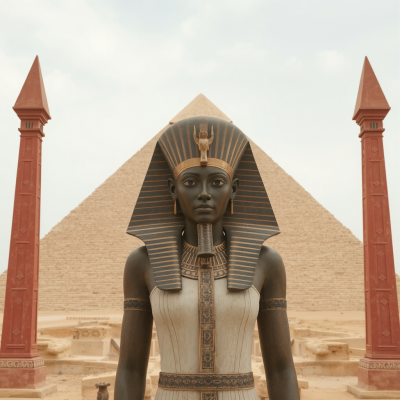Queens and Mothers: Hatshepsut, the Female Pharoah (Egypt)

Hatshepsut erected multiple obelisks (Imagined by Gencraft AI)
Hatshepsut: Egypt’s Unforgettable Female Pharaoh
The Royal Birth of a Trailblazer
Born in the 15th century BC, Hatshepsut was the daughter of Pharaoh Tuthmose I and Queen Aahmes, both of royal lineage. Among their three children, Hatshepsut stood out as the favored one. Her two brothers died young, placing her in a unique position to inherit power. At a time when female rulers were virtually unheard of in Egypt, this created a remarkable opportunity for her future.
Seizing Power Through Circumstance
When Tuthmose I died, his son by a commoner, Tuthmose II, ascended the throne. Though technically the ruler, he was plagued by illness and possibly a skin disease, as observed from markings on his mummy. His reign lasted only three to four years. During this brief period, Hatshepsut, his half-sister and wife, seemed to have been the real power behind the throne. Their union produced no sons, but Tuthmose II did father a boy with another commoner, Isis. That son, Tuthmose III, was the rightful heir but was too young to rule. Hatshepsut was named queen-dowager and regent.
Rising as Pharaoh
Instead of waiting for Tuthmose III to come of age, Hatshepsut made a bold move. She declared herself Pharaoh, taking full control of Egypt. As the beloved daughter of a popular king and a charismatic woman in her own right, she won strong support from court officials and the priesthood. Her reign lasted around 20 years, ending with her death in 1458 BC. During this time, she commissioned more temples, statues, and works of art than any Egyptian queen before or after her.
Gender, Power, and Propaganda
Being a woman in a man’s role posed major challenges. Hatshepsut used clever political strategies and powerful imagery to assert her legitimacy. She appeared in statues and reliefs as a male king, wearing the traditional shendyt kilt, nemes headdress, and even a false beard. She adopted all royal titles and referred to herself in masculine terms.
To reinforce her rule, she promoted grand projects such as expeditions to the land of Punt (modern-day Somalia). These missions brought back exotic goods like ivory, incense, animals, and myrrh trees. Hieroglyphs at her temple detail these adventures and include humorous depictions of the Puntite queen, whose physical features fascinated and perhaps amused the Egyptians.
The Marvel of Deir el-Bahri
To cement her legacy, Hatshepsut ordered the construction of a grand mortuary temple at Deir el-Bahri, across the Nile from Thebes. Built against towering cliffs, the temple stood as a testament to her divine rule and vision. It included detailed inscriptions and reliefs portraying her divine birth and mission. In one notable scene, the god Amon-Re is shown visiting her mother, Aahmes, in the form of Tuthmose I. According to the inscription, their union resulted in Hatshepsut’s divine conception.
This story supported her claim of being chosen by the gods. She also emphasized that her father had personally selected her as successor, quoting the divine potter Khnum:
“I will make you the first of all living creatures. You will rise as king of Upper and Lower Egypt, as your father Amon, who loves you, did ordain.”
Political Tensions and the Fall of Senmut
Despite her efforts, Hatshepsut’s reign wasn’t free from threats. Tuthmose III grew older, and with him grew resentment. He had no real power during her lifetime and likely disliked her close adviser, and rumored lover, Senmut. Senmut was a talented architect and statesman who designed many of Hatshepsut’s temples. He even planned a tomb for both of them, but after his death, his sarcophagus was smashed into over 1,200 pieces. His mummy was never recovered.
The fate of Hatshepsut’s daughter, Nefrure, is equally mysterious. Some believe that after Hatshepsut’s death, Tuthmose III may have eliminated them both, along with Senmut. Whether or not he directly caused their deaths, his actions after her reign suggest deep resentment.
Erasing Her Legacy
After Hatshepsut’s death, Tuthmose III systematically erased her name from monuments, statues, and inscriptions. Since she had often depicted herself as a male pharaoh, the edits were relatively easy. He replaced her name with that of earlier kings such as Tuthmose I, II, or III.
Some of her greatest works, such as the red granite obelisks she erected at Karnak, were covered in stone masonry. Their gilded tips were likely the only parts left exposed. One of the obelisks was later destroyed entirely. Her temple at Deir el-Bahri was defaced, and her name was omitted from the records of kings.
The Hatshepsut Problem
Hatshepsut’s reign puzzled archaeologists for years. In the early 20th century, scholars like Edouard Naville and Kurt Sethe debated the order of the Tuthmosid dynasty. Since Hatshepsut’s name was erased and replaced, many originally assumed she had only acted as regent. But the discovery of the tomb of Ineni, an architect who served during her reign, helped clarify the true sequence. He confirmed her status as pharaoh, not just a placeholder.
The confusion over the erasures and altered timelines led to what is now called the “Hatshepsut Problem” in Egyptology. Only in recent decades has her story begun to be restored.
A Legacy Carved in Stone
Despite efforts to erase her from history, Hatshepsut’s impact endures. She expanded trade, built magnificent temples, and ushered in an era that was both peaceful and prosperous. Her mortuary temple remains one of Egypt’s most visited archaeological sites. Even without a body to bury, her spirit lives on through her monumental achievements.
She was the first woman to rule Egypt as Pharaoh, not queen. She claimed divine right, ruled wisely, and left a mark that even time and her enemies could not fully erase. Hatshepsut stands today as a symbol of resilience, leadership, and ambition.
The story of Hatshepsut is a lesson that history is not always written by victors; sometimes, it is rewritten by those who fear the legacy of greatness.
Read about more Queens
